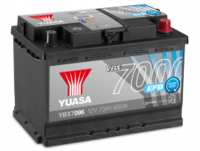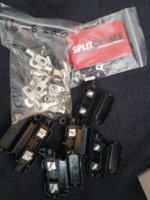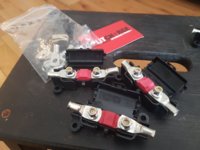So
With all the talk regarding the Bluemotion thing and regen breaking and leisure batteries our T6 has finally arrived.
The first thing we done was to checkout the factory fitted setup,......
Stop/start=check,
Regen Braking=check,
AGM starter battery=check
leisure battery under passenger bench-standard lead acid=oops!
standard relay and fuse holder for charging thge leisure battery=check . . . hmmm?
So the factory standard setup is stop/start/regen with AGM starter battery, ok, so i ask the sales guy why i haven't got a second AGM battery under the passenger seat, (for balanced charging from regen etc).... he goes and gets a technician. ..... The tech says thats totally normal and supposed to be that way. i mentioned about the 80% charge levels for regen etc and about the relay for split charging!!! all totally normal he says......? Now im confused...have VW got it all wrong? surly not?
He then goes on to tell me that as long as the BCM etc is programmed for the leisure battery then the charging system etc is fine. The 100A split-charge relay is fine. the 80A supply fuse is fine, The lead-acid leisure battery is fine. The AGM starter battery is fine......All is good in the world...........
BUT !!!!!!! he did say that the problems come from people who have fitted the leisure battery/split charge setup themselves as the BCM hasn't been programmed for that scenario and the charging strategy isn't assuming the extra load of charging the second leisure battery......? (plausible i thought)
So i left the dealers with the van now more confused than ever. My questions to myself..
Do i need AGM batteries for both starter and Leisure?
Do i need a third party DC-DC charger?
Is the factory split charge relay good enough?
Do i fancy a ham sandwich?
Beer or Cider tonight?
............................hmmm decisions decisions.....
i decided to do my own research ..........
below is the factory AGM battery.
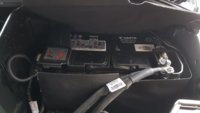
and the close-up
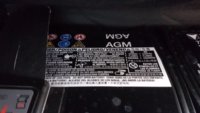
here is the factory split charge relay setup:
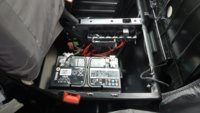
the 100A relay and 80A supply fuse.
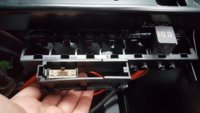
this is the factory leisure battery:
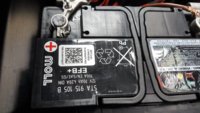
So thats the factory setup,
now here is the test results, these were gathered from two voltage data-loggers, one connected to the main starter battery and the second across the leisure battery.... over a 3hour period of the test drive, which included starting/stopping/regens/city and A road driving plus a half hour park up for good measure,
below is the readout for the main AGM battery
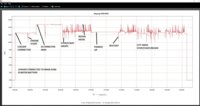
and below is the readout for the Leisure battery:
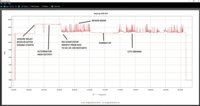
here is my conclusion from what i can see...
The leisure battery is disconnected at initial engine startup so no effect on it at startup.
The smart alternator seems to have gone to a high output setting @ 14.8v , presumably while the engine is warming up and boost charging the battery (and leisure battery) for the first 15-20mins of the drive cycle.(i may have had the heated seats on too?)
when start/stop kicks in, the leisure battery stays connected but is un-effected by the starter drain (low 10v when cranking), im assuming that the factory DC-DC charger keeps the voltage up and stabilized while the starter is cranking.
The regen breaking phases show charging spikes of around 14.8v accross both the starter and leisure battery's. (obviosly as they are both connected via the split-charge relay)
The average voltage the leisure battery sees is above the 12.6v assumed for as a charged battery (about 12.8v - 13-8v)
From what we can see the factory split charge setup seems to be up to the job for the basic battery . . . . . . . .
But im going to assume that old-skool charging would be way better for the AUX battery. A fixed 13.8v constant charge would be more beneficial at keeping it charged compared to the spiky pulsed charge its getting from the regen (plus bulk charge after starting)......so the DC-DC charger would help here.
one next test i need to do is run the AUX battery low/flat and see what happens then?.........basically will it receive enough charge, or will it charge up well enough after a drive?
The upgrade would be Dual AGM batteries and a third party DC-DC charger im assuming.
if/when i upgrade ill redo these tests and see what the difference is.....
now over to you guys...... now seeing this, what are your thoughts?
Factory split charge? or duel AGM and 3rd party DC-DC charger?
With all the talk regarding the Bluemotion thing and regen breaking and leisure batteries our T6 has finally arrived.
The first thing we done was to checkout the factory fitted setup,......
Stop/start=check,
Regen Braking=check,
AGM starter battery=check
leisure battery under passenger bench-standard lead acid=oops!
standard relay and fuse holder for charging thge leisure battery=check . . . hmmm?
So the factory standard setup is stop/start/regen with AGM starter battery, ok, so i ask the sales guy why i haven't got a second AGM battery under the passenger seat, (for balanced charging from regen etc).... he goes and gets a technician. ..... The tech says thats totally normal and supposed to be that way. i mentioned about the 80% charge levels for regen etc and about the relay for split charging!!! all totally normal he says......? Now im confused...have VW got it all wrong? surly not?
He then goes on to tell me that as long as the BCM etc is programmed for the leisure battery then the charging system etc is fine. The 100A split-charge relay is fine. the 80A supply fuse is fine, The lead-acid leisure battery is fine. The AGM starter battery is fine......All is good in the world...........
BUT !!!!!!! he did say that the problems come from people who have fitted the leisure battery/split charge setup themselves as the BCM hasn't been programmed for that scenario and the charging strategy isn't assuming the extra load of charging the second leisure battery......? (plausible i thought)
So i left the dealers with the van now more confused than ever. My questions to myself..
Do i need AGM batteries for both starter and Leisure?
Do i need a third party DC-DC charger?
Is the factory split charge relay good enough?
Do i fancy a ham sandwich?
Beer or Cider tonight?
............................hmmm decisions decisions.....
i decided to do my own research ..........
below is the factory AGM battery.

and the close-up

here is the factory split charge relay setup:

the 100A relay and 80A supply fuse.

this is the factory leisure battery:

So thats the factory setup,
now here is the test results, these were gathered from two voltage data-loggers, one connected to the main starter battery and the second across the leisure battery.... over a 3hour period of the test drive, which included starting/stopping/regens/city and A road driving plus a half hour park up for good measure,
below is the readout for the main AGM battery

and below is the readout for the Leisure battery:

here is my conclusion from what i can see...
The leisure battery is disconnected at initial engine startup so no effect on it at startup.
The smart alternator seems to have gone to a high output setting @ 14.8v , presumably while the engine is warming up and boost charging the battery (and leisure battery) for the first 15-20mins of the drive cycle.(i may have had the heated seats on too?)
when start/stop kicks in, the leisure battery stays connected but is un-effected by the starter drain (low 10v when cranking), im assuming that the factory DC-DC charger keeps the voltage up and stabilized while the starter is cranking.
The regen breaking phases show charging spikes of around 14.8v accross both the starter and leisure battery's. (obviosly as they are both connected via the split-charge relay)
The average voltage the leisure battery sees is above the 12.6v assumed for as a charged battery (about 12.8v - 13-8v)
From what we can see the factory split charge setup seems to be up to the job for the basic battery . . . . . . . .
But im going to assume that old-skool charging would be way better for the AUX battery. A fixed 13.8v constant charge would be more beneficial at keeping it charged compared to the spiky pulsed charge its getting from the regen (plus bulk charge after starting)......so the DC-DC charger would help here.
one next test i need to do is run the AUX battery low/flat and see what happens then?.........basically will it receive enough charge, or will it charge up well enough after a drive?
The upgrade would be Dual AGM batteries and a third party DC-DC charger im assuming.
if/when i upgrade ill redo these tests and see what the difference is.....
now over to you guys...... now seeing this, what are your thoughts?
Factory split charge? or duel AGM and 3rd party DC-DC charger?
Last edited:

